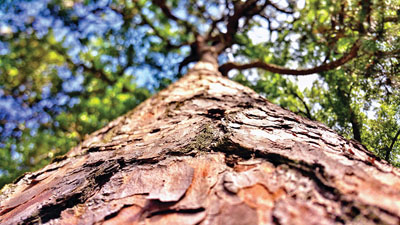Traipsing Through the Trees

By Chelsea Pyne
November is the perfect time to take advantage of the last of fall weather. Gather supplies, drive to the Blue Ridge Parkway, and set up camp. Spend a few days with family and friends in the fresh mountain air. Even one weekend away from our stress-laden, technology-filled lives will do wonders for the soul.
Actually, a single walk in the woods has its benefits. Even more so, walking barefoot in nature aka “grounding” is said to be a great way to detox the body. This has to do with our body connecting to earth’s negative charge, which is greater than our own. Our bodies absorb earth’s electrons and this effect gives us antioxidants and helps with inflammation. No matter the science behind it, who does not enjoy kicking off their shoes and wiggling their toes in some good old Carolina dirt?
This is all beside the point. Nature is wonderful in many ways, but did you know there are secrets and clues in every plant, rock, and path?
For instance, have you noticed that gardeners tend to keep stakes relatively short for immature saplings? The more wind a tree has to tolerate, the shorter it will grow and the stronger it becomes. This is one of the reasons that the tallest trees in the forest tend to be inland, protected by other, thicker trees. Trees literally bulk up depending on the strength of their local winds. This is a growth response that all trees have and it is why gardeners cannot give the saplings too much help early on. The tree will become too tall and too weak for the normal winds in the area if they are “babied” during the early years. Tough tree love.
Something that we have been seeing often is the changing foliage. This is due to the chemical reaction of chlorophyll breaking down inside the leaves. Green to yellow, yellow to orange, orange to red…one of the most glorious deaths Nature offers. Besides this seasonal change, we often see trees with dead leaves (say, in the middle of spring). This happens when the leaves do not receive enough light. The trees’ response is to shut down those leaves, followed by the branch, and then the withering process begins. Sometimes half of the tree will be straight and strong while the other half is droopy.
The next time you are beyond the manicured lawns of the neighborhood, look for some of nature’s other tree signs. Say you are hiking in the mountains but suddenly the trail no longer resembles a path. An easy way to get oriented is to take off your shoes and socks, wait ten minutes with your feet in the mud, and let the earth speak to you.
Just kidding. Simply look up. Granted you are surrounded by trees, it is quite easy to find your direction. The sun kissed tips of trees always lean towards south. Another way is to look at the tree’s bark. It is more dull and dark on the northern side. If you want to be super sure of your direction, make a couple of incisions with an axe. Compare the rings in the trunk of the tree and find where they grow thicker and thinner. The thicker rings will face north and the thinner rings point south.
Say you just happened to be in a treeless area, but there are at least weeds around. You can find the south-north line by working backward from taller weeds to shorter ones. Hopefully from there, your cellphone will receive a signal and you can Uber back to camp. Unless you really played by the rules and left the phone at home…then kudos to you! Someone will find you, eventually.
Nevertheless, as we welcome in the last fall days let’s take advantage of the beautiful, natural scenery that this small town allows. We are lucky to have such fresh air in Kernersville, that many other cities do not have the pleasure of breathing. So get outside while you still can, and search for more clues nature has to show–it is good for you!

